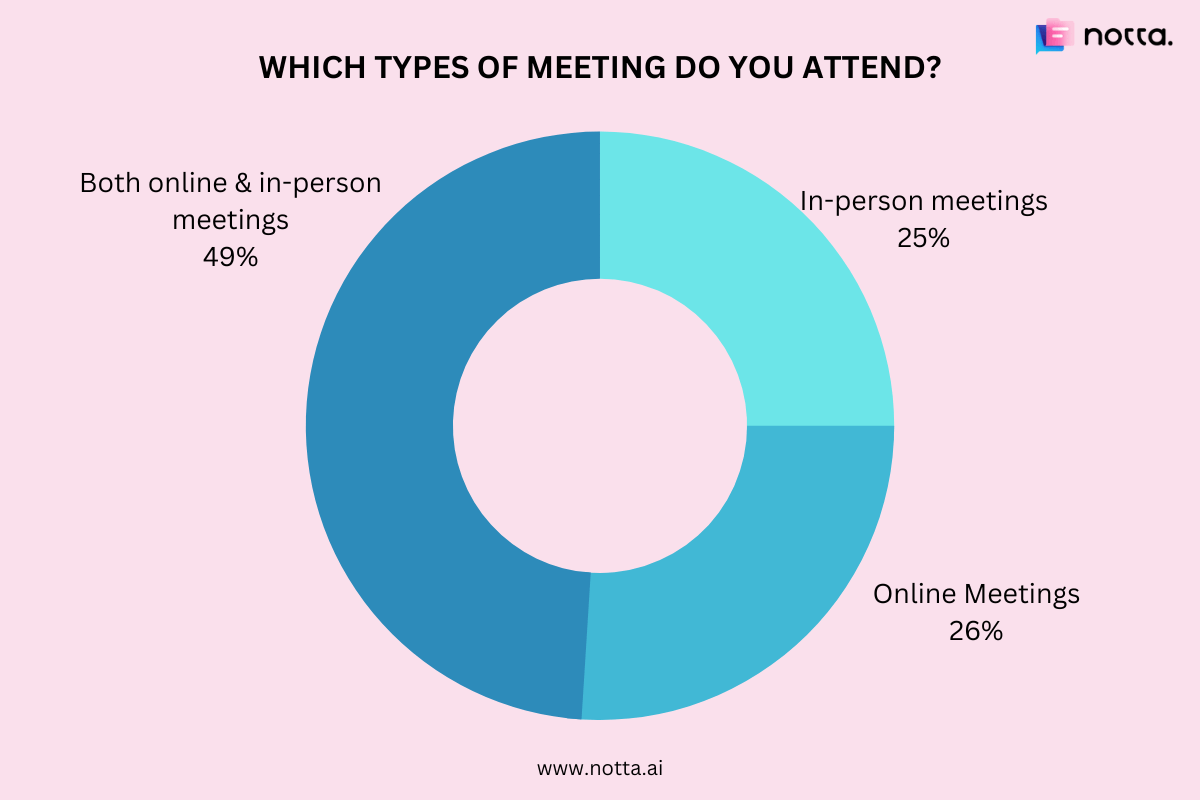
100+ Eye-opening Meeting Statistics in 2025: Virtual, Productivity & More
Unlock the power of AI — Notta's meeting assistant records, transcribes and summarizes meeting minutes with one click.
The way we conduct meetings has evolved significantly in recent years due to the pandemic, advancements in technology, and the changing work culture. This evolution has been somewhat complicated and confounding to business experts.
For example, when the pandemic hit, the adoption of remote work made virtual meetings the norm in many organizations, and video conferencing tools became more popular. But when we thought that in-person meetings had finally been laid to rest, the world opened up and physical meetings are making a comeback.
As a professional, it is important to keep up with the latest meeting statistics in the workplace to understand how meetings are evolving and how to optimize them for better outcomes. For instance, modern tools let you easily convert audio to text for clearer meeting records.
In this comprehensive article, I'll reveal the 100+ eye-opening meeting statistics, highlighting the key trends and changes that are shaping the industry.
Key meeting insights you should know
Before diving deep into the meeting statistics, here is a quick meeting research summary and key findings.
11 million meetings are held every day in the United States. This translates to 55 million meetings every week and over 1 billion per year.
The majority (83.13%) of employees spend up to one-third of their workweek in meetings.
On average, organizations spend roughly 15% of their time in meetings.
An estimated $37 billion is lost due to unproductive meetings per year.
Only 30% of meetings are considered productive and 37% of workplace meetings actively use an agenda.
71% of professionals lose time every week due to canceled or unnecessary meetings.
The average meeting length increased by 8% - 10% every year between 2000 - 2020.
55% of remote workers think that a majority of meetings “could have been an email.”
Executives consider more than 67% of virtual meetings to be failures.
92% of the workers spent time multitasking during virtual meetings.
70% of workers believe virtual meetings are less stressful.
58% of introverts experience Zoom fatigue compared to 40% of extroverts.
Statistics on the time spent in meetings
Do you feel that you have attended more meetings while working from home, well, you feel it right. Most of us spend a lot of time in meetings — though it can vary depending on the job role and company.
1. Remote work has led to a huge increase in meetings
A survey by Harvard Business Review revealed that the number of meetings attended by a worker on average rose by 13.5% during the pandemic when remote work was at its peak.
This is corroborated by the Buffer State of Remote Work Report, which gathered data from over 2,000 remote workers worldwide to observe the shifts and evolution in remote work, 61% of workers said that they are in more meetings as a result of COVID-19-forced remote work.
2. Around 83% of employees spend up to 1/3 of their workweek in meetings
As a content strategist, I understand the importance of setting aside a large chunk of time — especially when I do my long-form writing, but the recurring team meetings and 1:1s make it hard to find time.
Apparently, I am not the only person struggling with the quantity of meetings.
According to the Dialpad survey conducted with over 2,800 US people who worked for businesses of all sizes and across different industries, 83.13% of people spend up to ⅓ of the week in meetings. More specifically:
Less than 4 hours - 46.15%
4-12 hours - 36.98%
12-20 hours - 12.14%
20 hours or more - 4.73% (that means they spend 50% or more of work hours in meetings)
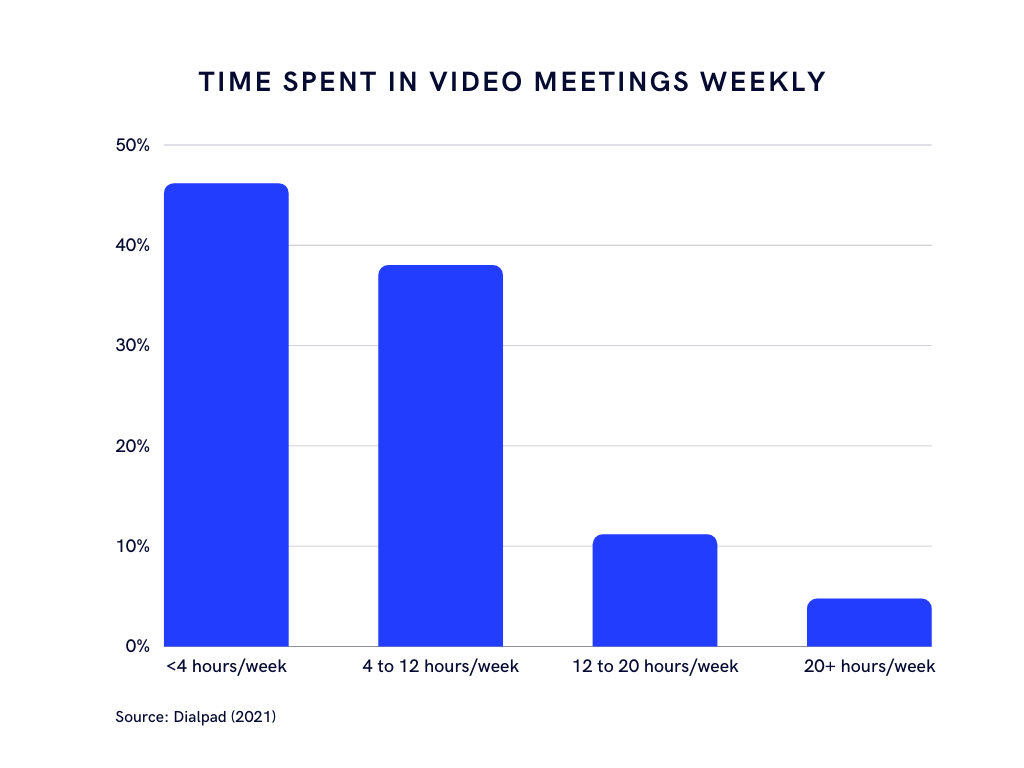
Guess which industry holds the most meetings? The marketing and advertising industry!
3. The average number of meetings attended varies by job title
A study by Harvard Business Review reveals that meetings are becoming longer and more frequent than ever. Of these, executives suffer the most — they spend almost 23 hours per week in meetings, which is more than double that in the 1960s. More specifically:
CEO - At least 37 meetings per week.
VPs and top-level executives - between 12 and 17 meetings every week
Junior level employees - 10 meetings
And when we count specific meeting time, CEOs spend 72% of work time in meetings, upper management spends 50%, middle management, and employees spend roughly 35% of their time in meetings.
As expected, 45% of employees admitted to feeling overwhelmed by attending too many meetings.
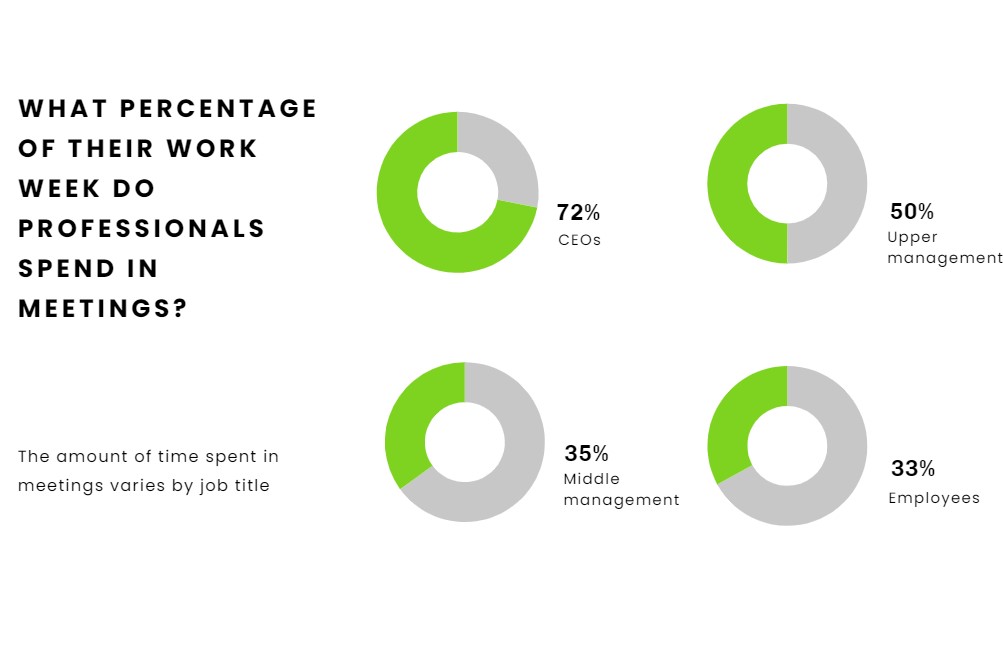
4. 71% of professionals lose time every week due to unnecessary or canceled meetings
In any week, I normally spend between 5-6 hours in meetings. Don't get me wrong — most of these meetings are productive and even necessary. But what can be a hassle is the unnecessary or canceled meetings.
Doodle's report also reveals that 71% of working professionals (overall) lose time every week due to this reason. Here are some statistics revealed by Doodle where professionals waste time in poorly organized meetings.
68% of US respondents
72% of UK respondents
74% of German respondents
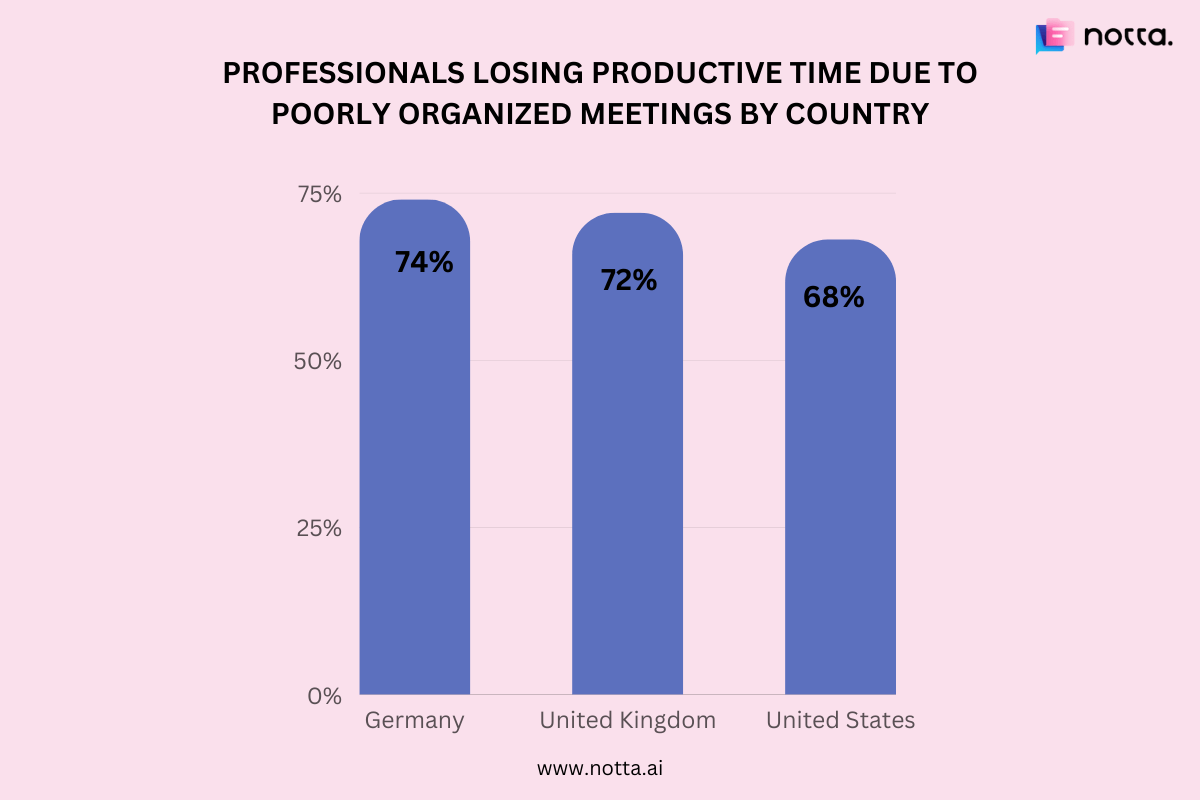
5. The majority (74.5%) of meetings last within 60 minutes
Deputy surveyed 3,280 workers in the US across different states and industries. When asked how much time they spend in meetings:
13.5% said that their average meeting ended in less than 15 minutes
19.2% spend between 15 and 30 minutes
41.8% spend between 30 minutes and an hour on average in meetings
22.5% said that meetings last up to two hours
2.9% stated that their meetings exceed the two-hour mark on average
6. Meeting length differs across industries
There are also differences in how much time employees spend on average across different industries.
Legal services - Between 1 and 2 hours
Law enforcement - 30 minutes to two hours
Media and broadcasting - 30 minutes to an hour
Food service industry - Typically less than 30 minutes
Military industry - Less than 15 minutes
7. 70% of professionals believe morning — 8 a.m. to 12 p.m. — is the best time to schedule meetings
Talking feels easier than writing, and that's why we tend to schedule meetings often. But one thing that matters for an effective session is the time of the meeting.
Doodle's report also revealed that 70% of professionals feel that morning — 8 a.m. to 12 a.m. — is the best time to schedule a meeting, and 9% of workers prefer early hours (before work) between 6 a.m. to 8 a.m.
19% of respondents believe the afternoon hours — between 12 p.m. to 5 p.m. — are ideal.
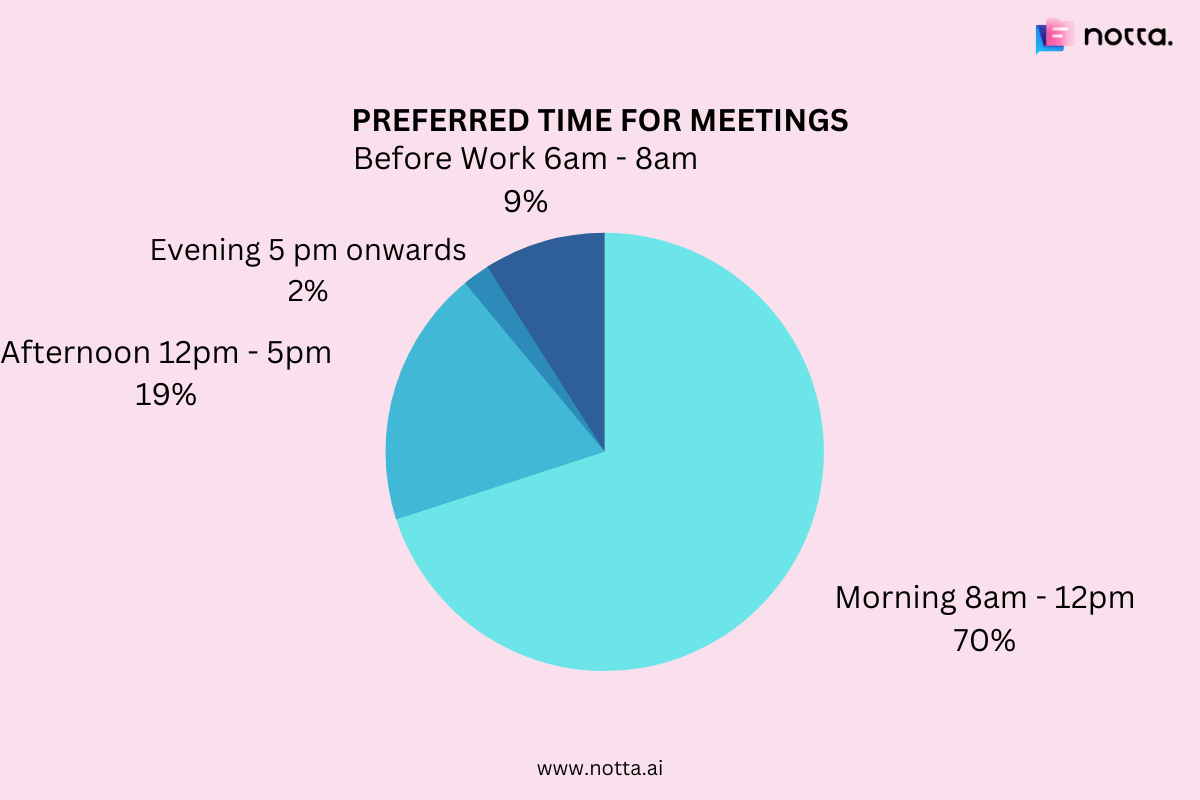
8. Ad hoc meetings are rising
37% of meetings are ad hoc and unscheduled, which is on the rise over the past two years (reported by 40% of workers).
Notta AI meeting assistant records, transcribes, and summarizes meetings so everyone can stay engaged without missing important details.
Virtual meeting statistics
Many organizations turned to remote work and virtual meetings as a way to continue operations during the lockdown and have worked the same way ever since.
Virtual one-on-one meetings increased by a staggering 1,230% from January to December 2020, while virtual group meetings rose by over 613%. Here are the stats you should know about remote meetings.
1. Virtual meetings grew from 48% to 77% between 2020 and 2022
This is evidence that virtual meetings have come to stay. The global video conferencing market also grew from $6.62 billion in 2022 to $7.26 billion in 2023 at a compound annual growth rate of 9.7%.
Zoom has been one of the fastest-growing apps during the pandemic, seeing its number of daily meeting participants increase by 2900% within months of the outbreak of COVID-19.
2. Do employees prefer virtual meetings?
We tend to think of virtual meetings as major time traps. But, as it turns out, many employees do not consider these meetings as the biggest issue that makes them put off work. Here's what the Owl Labs report indicates:
70% of remote workers said virtual meetings are less stressful.
71% find it easier to present to a group in virtual meetings.
67% believe virtual meetings are as productive as in-person sessions.
64% of respondents (who worked from home during the pandemic) chose hybrid video conferencing calls as their top meeting style.
While most employees prefer virtual meetings, nearly 15% of workers said these sessions were not as productive.
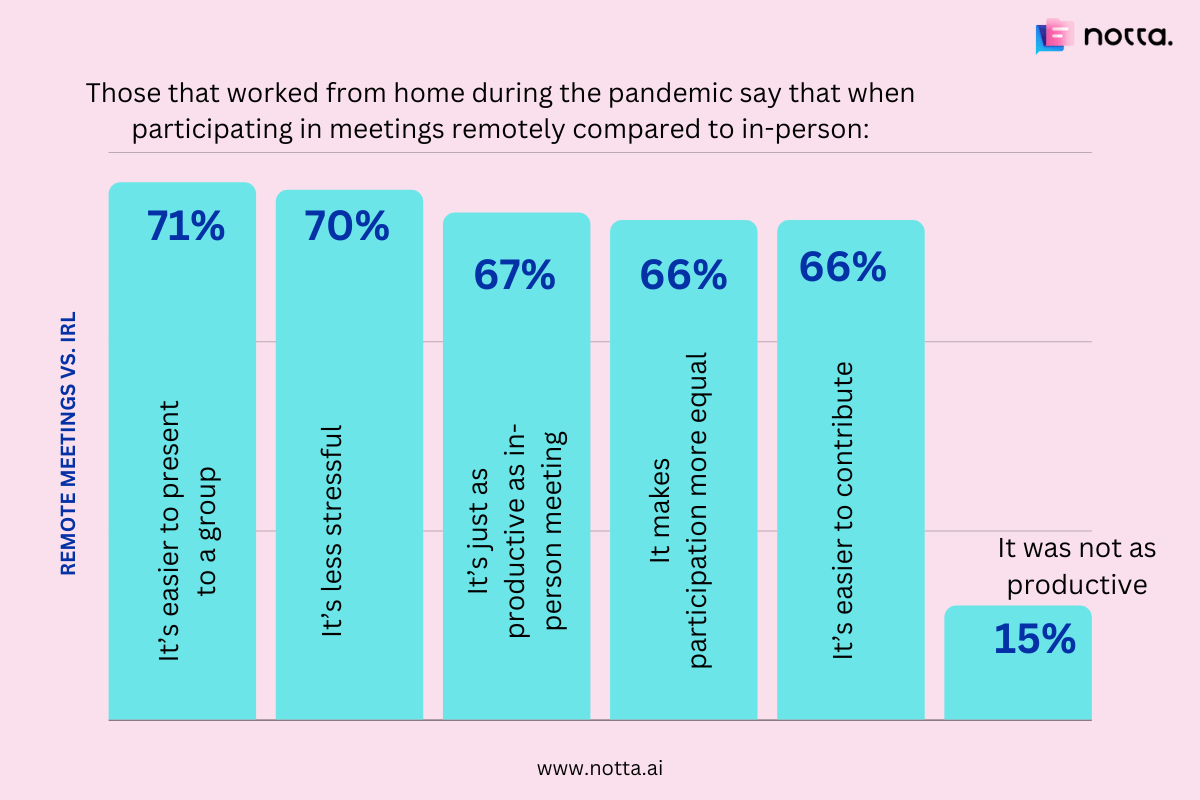
3. 43% of professionals consider on-camera meetings better for productivity
It is theorized that this might be connected to the fact that on-camera meetings reduce the ability of the majority of the respondents (66%) to multitask.
4. Virtual conference fatigue is real
Meeting fatigue is the new app fatigue, and employees often feel their day is dominated by video calls.
A HubSpot report supports this, with 49% of the respondents claiming that on-camera meetings make them more exhausted. 37.1% consider Zoom fatigue as the greatest challenge of virtual meetings.
And there are some more interesting insights about Zoom fatigue:
Women are 2.5 times more likely to experience Zoom fatigue than men.
1 in 7 women (13.8%) said they feel very to extremely fatigued after Zoom calls, compared to around 1 in 20 men (5.5%). A simple solution is to turn off your camera during meetings.
Introverts are more likely to experience Zoom fatigue than extroverts and ambiverts.
According to the HubSpot report, 58% of the respondents who identified as “introverts” reported that being on camera made them exhausted, compared to the 40% of “extroverts” who indicated this.
5. 88% of respondents believe video meetings are suitable for training and interviews, and many rely on voice memo to text solutions to keep records accurate.
A LoopUp report reveals a vast majority of employees — or more specifically, 88% — believe that video conferencing is useful for interviews and training.
Surprisingly, only 53% of these respondents believe video conferencing is for day-to-day meetings.
6. Impact of video conferencing
Meetings aren't all bad — in fact, some are not only essential but also essential. It becomes even more important for fully remote companies. That being said, we see a lot of companies adopting video conferencing tools to run effective remote meetings.
80% of workers rely on video conferencing platforms for one-to-one meetings.
78% believe video conferencing is great for team meetings and stand-ups.
Nearly 62% choose video for meetings with customers or partners.
In-person and hybrid meeting statistics
When the pandemic hit, some industry experts hastily predicted that it would mark the end of on-site work and in-person interaction for teams, spelling doom for the 1.5 billion people participating in face-to-face business events globally. At the same time, employees exploring hybrid setups often use mp4 to text converter to capture video discussions and the $1.5 trillion GDP they represent in global GDP.
However, things are rapidly changing with many teams returning to on-site work and adopting a hybrid of virtual and on-site work and events.
1. 25% of employees mainly attend in-person meetings
According to Livecareer's study, 25% of the respondents in the survey stated that they attend only or mainly attend in-person meetings. This figure is against the 26% that attend mainly online meetings and 49% that attend hybrid meetings.
2. 88% of companies have resumed planning physical events
According to TravelPerk, in-person meetings and events are making a comeback in 2022:
88% of companies are back to planning in-person events and team gatherings
50% of companies planning corporate events are prioritizing team-building gatherings to bring employees back together
79% of employees are most excited to get back to in-person events to meet their colleagues and build meaningful relationships
3. 47% of employees prefer in-person meetings
Zapier reveals that 47%, which represents almost half of employees, prefer physical meetings. This figure is compared against the 53% of employees who prefer virtual meetings.
But Livecareer’s report tells a slightly different story. According to the report, 50% of employees prefer in-person meetings, 40% prefer online meetings, and the remaining 10% expressed no preference.
4. Over 60% of employees who worked from home during the pandemic prefer hybrid meetings
64% of employees who worked remotely during the pandemic said that their top meeting style preference is a hybrid video conferencing call. The appeal of hybrid meetings is that they combine both features of in-person and virtual meetings.
5. The majority of professionals attend both online and in-person meetings
Hybrid meetings are undeniably the preferred meeting type in many organizations. 49% of professionals surveyed, which make up the majority, stated that they attend both online and in-person meetings.
Notta offers the most integrated AI meeting notes, summaries, and action items so nothing gets missed.
Statistics on unproductive meetings (time wasted)
Many people at work spend a lot of time checking emails and meetings. The State of Work Report reveals US workers spend 40% of their workday on their primary tasks, while 60% of the time goes wasted.
However, the fact that meetings get a lot of bad PR and most meetings are badly executed does not mean that they are inherently bad. 61% of professionals believe that meetings benefit employees. As we will see from the studies cited below, meetings, when done effectively, can transform employee productivity and the overall quality of an organization's output.
1. In the United States, $37 billion is lost to unproductive meetings annually
Alone, one big business can lose up to $300 million each year.
Organizations also lose 24 billion hours to inefficient meetings — many of which could be reduced by leveraging free transcription software.
2. 71% of managers and employees consider meetings a waste of time
The Harvard Business Review surveyed 182 senior managers in a range of industries, and the results are as follows:
71% of respondents believe meetings are unproductive and inefficient.
65% said meetings are the primary reason that keeps them from completing their work.
64% consider the meetings to come at the expense of deep thinking.
62% believe meetings miss opportunities to bring the team closer.
Only 17% of senior managers reported that their meetings are productive uses of group and individual time.
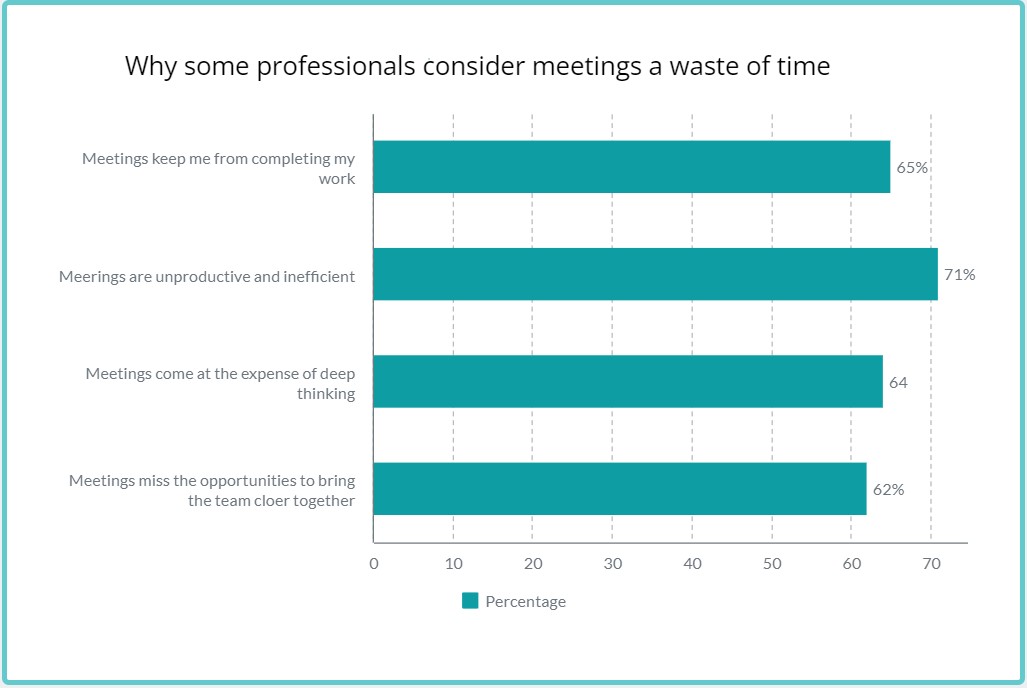
3. Factors that make meetings productive
According to respondents in a Doodle survey, the following are what makes a good meeting:
Setting clear meeting objectives – 72%
Having a clear agenda – 67%
Not having too many people in the room – 35%
Having a visual stimulus - 27%
4. Causes of unproductive meetings
With the fact that 70% of meetings are considered unproductive, it’s essential to know the reasons behind them.
Lack of clear objectives. 61% of C-suite executives believe that the lack of clear objectives is responsible for unproductive meetings.
Irrelevant meetings. 51% of professionals attribute meeting unproductivity to irrelevant meetings.
Scheduling overload. 78% of professionals identified scheduling overload as another factor contributing to unproductive meetings and early career professionals are the most affected by this problem. 38% of professionals blame upper management for this problem while 16% blame their direct manager.
Lack of meeting feedback. According to a report by Fellow, the lack of meeting feedback may contribute to hindering meeting productivity. Only 3.7% of respondents said that their company always collects meeting feedback.
Other factors responsible for unproductive meetings according to workers include:
Taking phone calls or texting during meetings - 55%
Participants interrupting one another - 50%
Not listening to the contributions of others - 49%
Arriving late or leaving early - 49%
Talking about nothing for long periods of time - 46%
Meetings perception and behavior statistics
1. Employees prefer audio-only meetings
82.9% of professionals do not consider video necessary in every meeting while 44.94% believe audio calls are more appropriate in any meetings that do not require screen sharing.
A LoopUp report revealed that 88% of professionals believe that video conferencing is most suited for interviews and training while 53% think it is appropriate for day-to-day calls. This shares the sentiments expressed in the Dialpad report above that video conferencing is not an all-purpose solution for virtual meetings.
2. The best day for a meeting is Tuesday and the worst is Monday
Generally, employees seem to favor days in the early to middle of the workweek for scheduling meetings.
In a survey where employees were asked what the best day for a meeting was, 29% chose Tuesday while 25% preferred Wednesday.
Further, a study by YouCanBookMe, which analyzed data from more than two million responses, concluded that 2:30 p.m. on Tuesday is the best time to schedule a meeting.
Meanwhile, 47% of employees consider Monday the worst day for a meeting. Friday is a close second, according to 40% of employees in the same survey.
3. 96% of professionals have missed meetings
If you are at work, it does not mean you are getting all your stuff done on time. Some of the culprits are excessive emails, constant interruptions, and, of course, pointless meetings. Here are some reasons employees gave for missing meetings:
75% of employees said that they simply didn’t feel like attending
32% blamed their absence on internet problems
28% said they missed meetings because of scheduling conflicts
27% had sick days
26% could not attend because of power outages
26% had problems with the Zoom app
22% said their computer updates were responsible
20% claimed they had doctor’s appointments
If you like most of these respondents tend to forget to join meetings or arrive late,I recommend using ai note taker so you never miss a meeting! Once set up, the Notta bot will join your online meeting at a scheduled start time.
What’s more? Notta also allows you to live record and automatically transcribe your meeting notes. These documents will thereafter be stored on your dashboard where you can retrieve them at any time. Having seamless, productive meetings has never been easier!
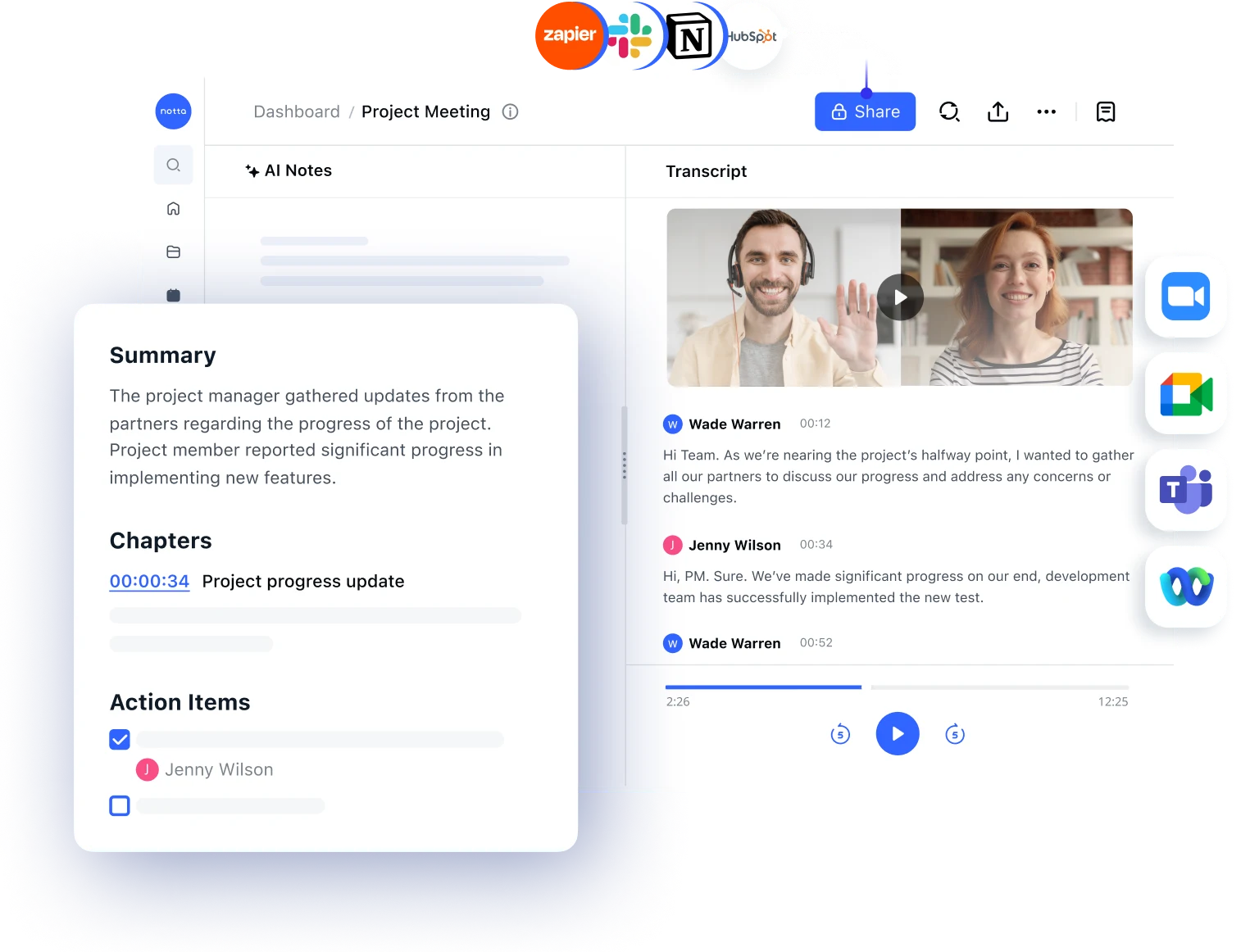
4. Only 37% of meetings in the workplace use agendas
Only an abysmal 37% of meetings in the workplace use agendas, in spite of its being considered very important by 73% of professionals and its potential to decrease the meeting time by up to 80%.
5. Employees multitask during meetings
A study by Muse revealed that 92% of employees unintentionally multitask during meetings while 41% admit that they multitask often or all the time during meetings.
49% said that they also do unrelated work instead of paying attention to the meeting while 55% of employees in remote meetings typically respond to and write emails. This is more common in long meetings.
Most surprisingly, 91% admit having daydreamed in meetings.
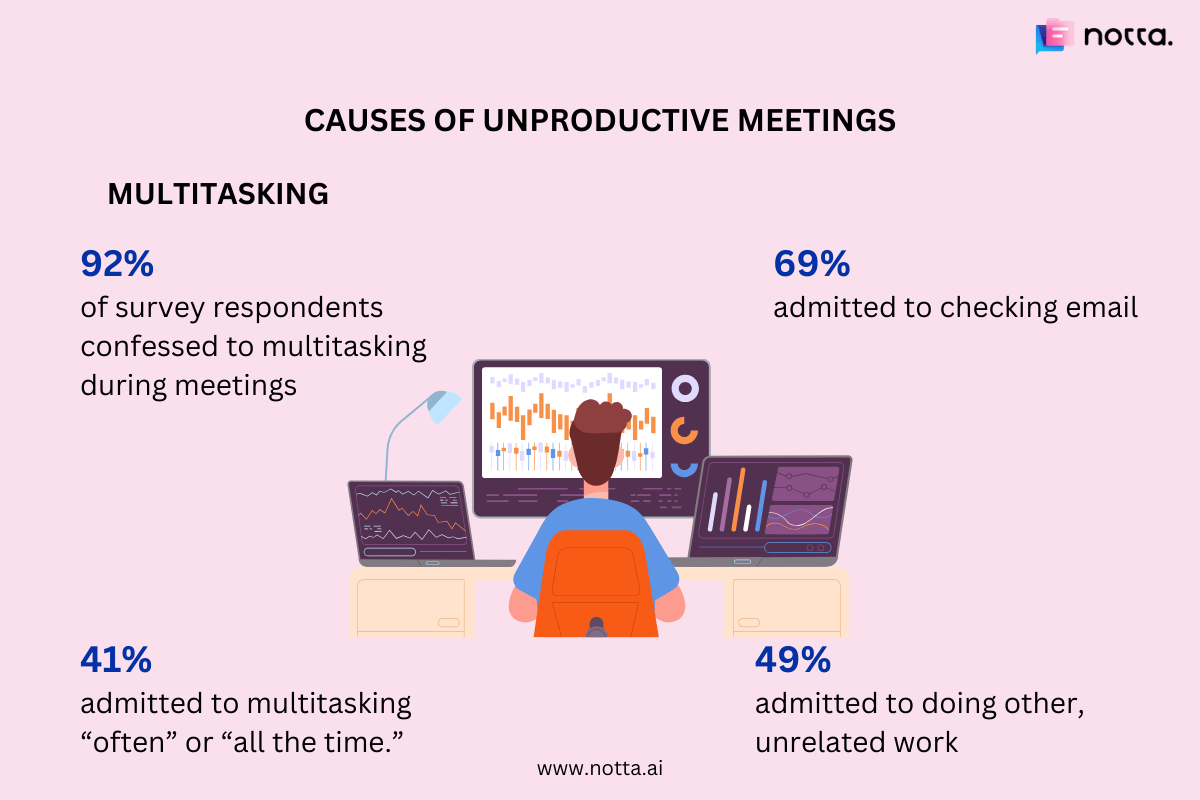
6. At least 75% of employees lose attention during meetings
Livecareer’s 2023 Meeting in the Workplace revealed that 75% of workers do not pay attention during meetings. Instead, they engage in a range of unrelated activities.
HR Digest found that a whopping 95% of meeting participants lose focus and miss parts of the meeting.
Activities that employees are most likely to engage in while at meetings include:
39% of the respondents read the news on the internet
38% browse social media or read a book
35% shop online
32% begin a text message conversation with a friend
31% play online or mobile games
28%) do other work-related tasks
27% draw or doodle
When the responses were analyzed along gender lines, it was discovered that the activity most preferred by women (40%), is online shopping while most men (40%) preferred to read the news.
7. Small talk and gossip are leading causes of disruption in meetings
54% of the professionals surveyed in the Udemy Workplace Distraction Report identified small talk and office gossip as the main causes of disruptions during meetings.
Other common disruptive factors identified in the report are:
Side discussions about other projects - 45%
Late arrivals/early departures - 37%
Technology/connectivity problems - 33%
8. 52% of employees start to lose attention in meetings between 0 and 30 minutes
Livecareer’s report confirms the fact that the majority of people have short attention spans and that it is important to consider this when planning meetings.
When respondents were asked, “How long does it take for people to start losing attention in meetings?”, their responses were as follows:
Less than 10 minutes - 9%
After 20-30 minutes - 43%
After 30-40 minutes - 30%
After 40-50 minutes - 14%
After 1 hour or more - 4%
In effect, 52% of attendees lose interest in the meeting after 30 minutes and 96% of attendees stop paying attention after 50 minutes.
9. 70% of employees think that starting meetings late is the most annoying meeting scenario.
This might be because starting meetings late only further wastes their time and extends the meeting longer than planned.
Other annoying scenarios according to how respondents ranked them are
Lack of a clear agenda or meeting plan - 69%.
Asking excessive or unnecessary questions during meetings - 66%.
Scheduling meetings too early in the day - 66%
Discussing topics that don't apply to everyone - 65%.
Going off-topic into areas unrelated to the meeting - 64%
Scheduling meetings too late in the day - 63%
Ending meetings later than their scheduled finishing time - 62%
Boring slide decks - 61%.
10. The reasons why employees like and dislike meetings
Reasons why respondents in the survey despise meetings include:
There are too many meetings - 69%
Having to work longer because meetings take too much time – 61%
Meetings drain their energy and demotivate them – 59%
Meetings, in general, are useless – 57%
Meetings kill creativity – 56%
Meetings distract and destroy workflow – 56%
Meetings are stressful – 52%
And employees like meetings because:
Meetings make decision-making easier - 74%
Time at work passes more quickly when they are in meetings - 71%
Meetings are great for networking - 71%
Meetings develop practical solutions that meet the needs of everyone present - 71%
With Notta, you can easily generate meeting minutes, turning spoken content into written records with 98.86% accuracy. Stay organized and capture every key detail in your meetings.
Statistics on the future of meetings
The pandemic has led to a decrease in in-person meetings and a rise in virtual sessions on video conferencing platforms (like Zoom, GMeet, Webex, and Microsoft Teams), but some reports reveal that 2023 will mark a tentative return to in-person meetings and rapid adoption of technology.
1. The number of meetings will increase in 2023
Per the 63rd International Meeting Statistics Report 2022 released by UIA (Union of International Organizations), the number of meetings would increase by 11% in 2023. The figure will jump to 34% in the following five years and 37% in seven.
In the next five years, 34% of companies will widely adopt virtual reality technology for long-distance meetings so attendees feel they’re in the meeting. Similarly, many teams rely on youtube summarizer to condense long online sessions.
2. Virtual meetings will not go anywhere in 2023 and beyond
A poll by SurveyMonkey reveals:
56% of respondents come away with clear action items most of the time.
32% of people think, 'This meeting could have been an email.'
Zoom meeting statistics
From conferences and work meetings to night classes, Zoom is one of the popular web conferencing platforms preferred by many individuals and teams, and recordings can easily be archived using m4a to text converters. But what do the statistics reveal about Zoom? Let's reveal:
Zoom is a popular web conferencing platform with a market cap of $20.47 billion.
Zoom has nearly 300 million daily meeting participants, which is an increase of 2900% from the previous figure.
89% of people use Zoom for work, whereas 63% conduct Zoom meetings with their friends and family. 69% of people use Zoom for remote meetings.
In 2023, Zoom registered over 3.3 trillion annual meeting minutes with a market cap that exceeds $75 billion.
Statista's Global Consumer Survey indicates that Zoom is the third most popular chat app in the US, preceded by Facebook Messenger and FaceTime.
67% of people discovered Zoom from a friend or colleague, 6% from search engines, and 6% from Twitter.
Here are the Zoom meeting statistics from the survey when customers were asked, 'Which Zoom alternative would you use if Zoom were no longer available.'
50% voted for Google Meet
16% chose Skype
15% said Microsoft Teams
9% would use Cisco Webex
7% prefer Slack
7% voted for FaceTime
6% would use Whereby and GoToMeeting
As of 2022, Zoom had over 509,800 business customers with more than 10 employees.
Meeting statistics FAQs
When is the best day to have a meeting?
The best days to have a meeting are Tuesdays and Wednesdays. Most professionals and researchers seem to favor Tuesday the most while Wednesday is a close second.
How long does an average business meeting last?
An average business meeting lasts between 31 minutes and an hour.
What are the biggest time wasters in meetings?
The biggest time wasters in meetings include the lack of clear objectives or an agenda, poor time management, too many attendees, poor planning or preparation, unclear communication, multitasking, and technology issues.
How many people are needed for a meeting to be successful?
The number of attendees in a meeting is often determined by several factors including the type of meeting, the goal of the meetings, and the stakeholders. But it is generally agreed that the average meeting should have no more than 6-8 people.
What are the most common distractions in meetings?
Small talk and gossip are leading causes of disruption in meetings according to 54% of the professionals
How do you take notes effectively in a meeting?
51% of respondents in a survey by Fellow reveal that each attendee takes their individual notes during a meeting. This statistic means there will be different sources of truth, leading to misinformation. Note-taking during meetings can be frustrating for most attendees.
You attend a long meeting, note down the critical information, and find gaps while revisiting them. If this scenario sounds time-consuming, consider using AI meeting assistant tools like Notta to record, transcribe, and even summarize meetings with high accuracy. You can also transcribe in Spanish if your team works bilingually.
Conclusion
There's something about unnecessary meetings: they can take a lot of time and can lead to a major productivity loss. To be honest, I don't think all virtual meetings are useless.
From all these meeting statistics, it's clear that meetings should be shorter and have a proper agenda. In other words, meetings should be an exception instead of a rule. For more streamlined collaboration, tools like record lectures apps help capture educational or training sessions effectively.
References
Harvard Business Review: Stop the Meeting Madness
The Muse: How Much Time Do We Spend in Meetings? (Hint: It's Scary) | The Muse
Ovum & LogMeIn Study: Ovum & LogMeIn Study Finds Late Meetings Cost Executives 5 1/2 Days Per Year
Beezy 2021 Digital Workspace Report: Digital workplace trends & insights
Owl Labs Report: State of Remote Work 2021 | Owl Labs
Livecareer: Meetings in the Workplace | 2023 Statistics
Atlassian: You Waste A Lot Of Time At Work
GlobeNews Wire: Global Web and Video Conferencing SaaS Market to Reach $7.6 Billion by 2027
LoopUp: ENTERPRISE CONFERENCING
TravelPerk: 18 stats and trends that show that company events are back - TravelPerk
Lifesize: 2019 Impact of Video Conferencing Report
Kung Group Report: Survey Reveals 4 Transformational Remote Work Trends | Entrepreneur
Zippia: Virtual And Zoom Meeting Distraction Statistics [Survey] - Zippia
Business Adobe: The State of Work Report 2019
UIA (Union of International Organizations): 63rd International Meeting Statistics Report 2022
SurveyMonkey & Zoom Poll: SurveyMonkey & Zoom Poll: virtual meetings are here to stay
CompaniesMarketCap: Zoom (ZM) - Market capitalization
Statista: Zoom daily meeting participants worldwide 2020 | Statista
Backlinko: Zoom User Stats: How Many People Use Zoom in 2023?
Statista: Chart: The Most Popular Chat Apps in the U.S. | Statista
Statista: Number of Zoom customers with over 10 employees 2022 | Statista
WiFiTalents: Must-Know Virtual Meeting Statistics [Latest Report]
Udemy Research: 2018 Workplace Distraction Report | Udemy Research
Fellow: Meeting Statistics in 2021: The Future of Meetings Report | Fellow
Bain & Company: Time is your scarcest resource. Stop squandering it | Bain & Company
Harvard Business Review: Dear Manager, You’re Holding Too Many Meetings
